关系数据库设计
Relational Database Design¶
Introduction¶
Example

What about combining instructor and department?
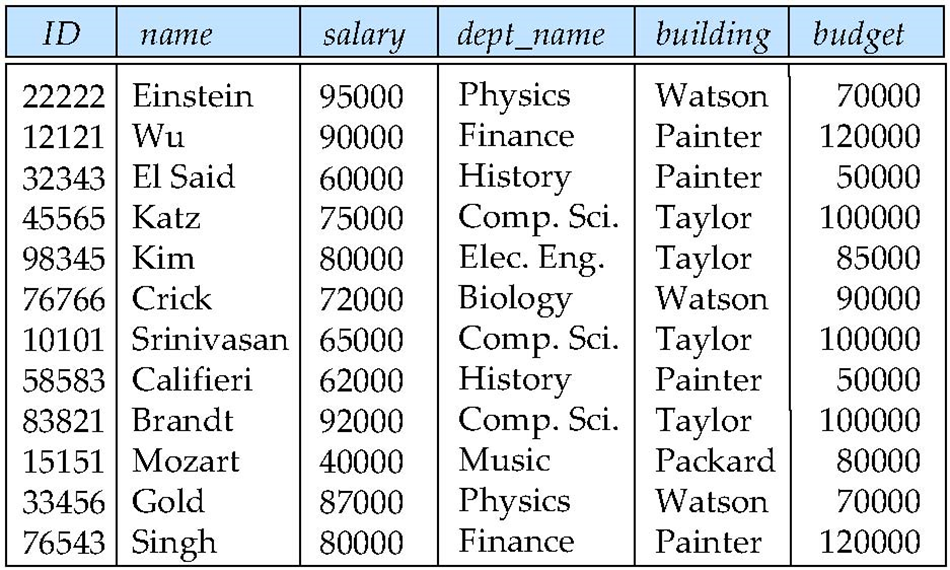
Pitfalls of the “bad” relations
- Information repetition (信息重复)
- Insertion anomalies (插入异常)
- Update difficulty (更新困难)
数据之间存在着隐含的函数约束关系,知道了 id 就可以决定其他元素。 e.g. id \(\rightarrow\) name, salary, dept_name; dept_name \(\rightarrow\) building, budget
产生冗余的原因是 dept_name 决定了部分属性,但他却不是这个表的 primary key.
好的关系:只有 candidate key 能决定其他属性。
拆表后要有重叠的属性,否则无法拼接回去。这里的公共属性必须是分拆出一个关系模式的 primary key, 这是无损(没有信息损失)连接。
lossy decomposition
employee(ID, name, street, city, salary) \(\rightarrow\) employee1 (ID, name) and employee2 (name, street, city, salary)

Example of Lossless-Join Decomposition

Lossless-join Decomposition¶
Let \(R\) be a relation schema and let \(R_1\) and \(R_2\) form a decomposition of \(R\). That is \(R = R_1 \cup R_2\).
We say that the decomposition is a lossless decomposition if there is no loss of information by replacing R with the two relation schemas \(R = R_1 \cup R_2\). Formally, \(r = \prod_{R_1}(r) \bowtie \prod_{R_2}(r)\).
And, conversely a decomposition is lossy if \(r\subset \prod_{R_1}(r) \bowtie \prod_{R_2}(r)\)
Note: more tuples implies more uncertainty (less information).
A decomposition of \(R\) into \(R_1\) and \(R_2\) is lossless join if at least one of the following dependencies holds: (充分条件)
- \(R_1\cap R_2\rightarrow R_1\)
- \(R_1\cap R_2 \rightarrow R_2\)
即公共属性是其中一个关系的 Key.
Devise a Theory for the Following¶
- Decide whether a particular relation R is in “good” form.
- In the case that a relation R is not in “good” form, decompose it into a set of relations \(\{R_1, R_2, \ldots, R_n\}\) such that
- each relation is in good form
- the decomposition is a lossless-join decomposition
如果关系是不好的,我们希望把它无损分解成好的关系。
- Our theory is based on:
- functional dependencies
- multivalued dependencies
- Normal Forms(NF): \(1NF \rightarrow 2NF \rightarrow 3NF \rightarrow **BCNF** \rightarrow 4NF\)
有些函数依赖,不能在 BCNF 中得到体现,需要把几个表拼在一起才能体现,叫依赖保持。这时我们需要从 BCNF 回到 3NF.
Functional Dependencies¶
Functional Dependencies are constraints on the set of legal relations. (来自于应用层面的规定)
Require that the value for a certain set of attributes determines uniquely the value for another set of attributes. e.g. dept_name \(\rightarrow\) building
A functional dependency is a generalization of the notion of a key.
Let \(R\) be a relation schema \(\alpha\subseteq R\) and \(\beta\subseteq R\) (\(\alpha, \beta\) 是属性的集合) The functional dependency \(\alpha\rightarrow \beta\) holds on \(R\) if and only if for any legal relations \(r(R)\), whenever any two tuples \(t_1\) and \(t_2\) of \(r\) agree on the attributes \(\alpha\), they also agree on the attributes \(\beta\). That is,
通过数据库实例可以证伪函数依赖,但不能证实。(依赖是来自应用层面的规定,先有函数依赖,再有数据库中的数据)
Example

\(A\rightarrow B\) 可以证伪,但也不能因此就说 \(B\rightarrow A\)
- K is a superkey for relation schema \(R\) if and only if \(K\rightarrow R\)
- K is a candidate key for \(R\) if and only if
- \(K\rightarrow R\), and
- for no \(\alpha\subset K\), \(\alpha\rightarrow R\)
A functional dependency is trivial if it is satisfied by all relations.
全集可以决定子集。
In general, \(\alpha\rightarrow \beta\) is trivial if \(\beta\subseteq \alpha\)
Closure(闭包)¶
Closure of a Set of Functional Dependencies¶
Given a set \(F\) of functional dependencies, there are certain other functional dependencies that are logically implied by \(F\).
The set of all functional dependencies logically implied by \(F\) is the closure of \(F\). We denote the closure of \(F\) by \(F^+\).
e.g. \(F=\{A\rightarrow B,B\rightarrow C\}\) then \(F^+=\{A\rightarrow B, B\rightarrow C, A\rightarrow C, AB\rightarrow B, AB\rightarrow C,\ldots\}\)
We can find \(F^+\), the closure of \(F\), by repeatedly applying Armstrong’s Axioms:
- if \(\beta\subseteq \alpha\) then \(\alpha \rightarrow \beta\) (reflexivity, 自反律)
- if \(\alpha\rightarrow \beta\) then \(\gamma \alpha \rightarrow \gamma \beta\) (augmentation, 增补律)
- if \(\alpha\rightarrow \beta\) and \(\beta \rightarrow \gamma\) then \(\alpha\rightarrow \gamma\) (transitivity, 传递律)
These rules are
- Sound(正确有效的) generate only functional dependencies that actually hold
- Complete(完备的) generate all functional dependencies that hold
Example

Additional rules:
- If \(\alpha\rightarrow \beta\) holds and \(\alpha\rightarrow \gamma\) holds, then \(\alpha\rightarrow \beta\gamma\) holds (union, 合并)
- If \(\alpha\rightarrow \beta\gamma\) holds, then \(\alpha\rightarrow \beta\) holds and \(\alpha\rightarrow \gamma\) holds (decomposition, 分解)
- If \(\alpha\rightarrow \beta\) holds and \(\gamma \beta\rightarrow \delta\) holds, then \(\alpha \gamma\rightarrow \delta\) holds (pseudotransitivity,伪传递)
Example

函数依赖,右边的公共属性可以去掉,使得函数双方没有交集。
Closure of Attribute Sets¶
Given a set of attributes \(a\), define the closure of a under \(F\) (denoted by \(a+\)) as the set of attributes that are functionally determined by \(a\) under \(F\)

Example

Uses of Attribute Closure¶
- Testing for superkey: To test if \(\alpha\) is a superkey, we compute \(\alpha+\), and check if \(\alpha+\) contains all attributes of \(R\).
- Testing functional dependencies
- To check if a functional dependency \(\alpha\rightarrow \beta\) holds (or, in other words, is in \(F+\)), just check if \(\beta\subseteq\alpha+\).
- That is, we compute \(\alpha+\) by using attribute closure, and then check if it contains \(\beta\).
- Is a simple and cheap test, and very useful
- Computing closure of F For each \(\gamma\subseteq R\), we find the closure \(\gamma+\), and for each \(S \subseteq \gamma+\), we output a functional dependency \(\gamma\rightarrow S\).
Example
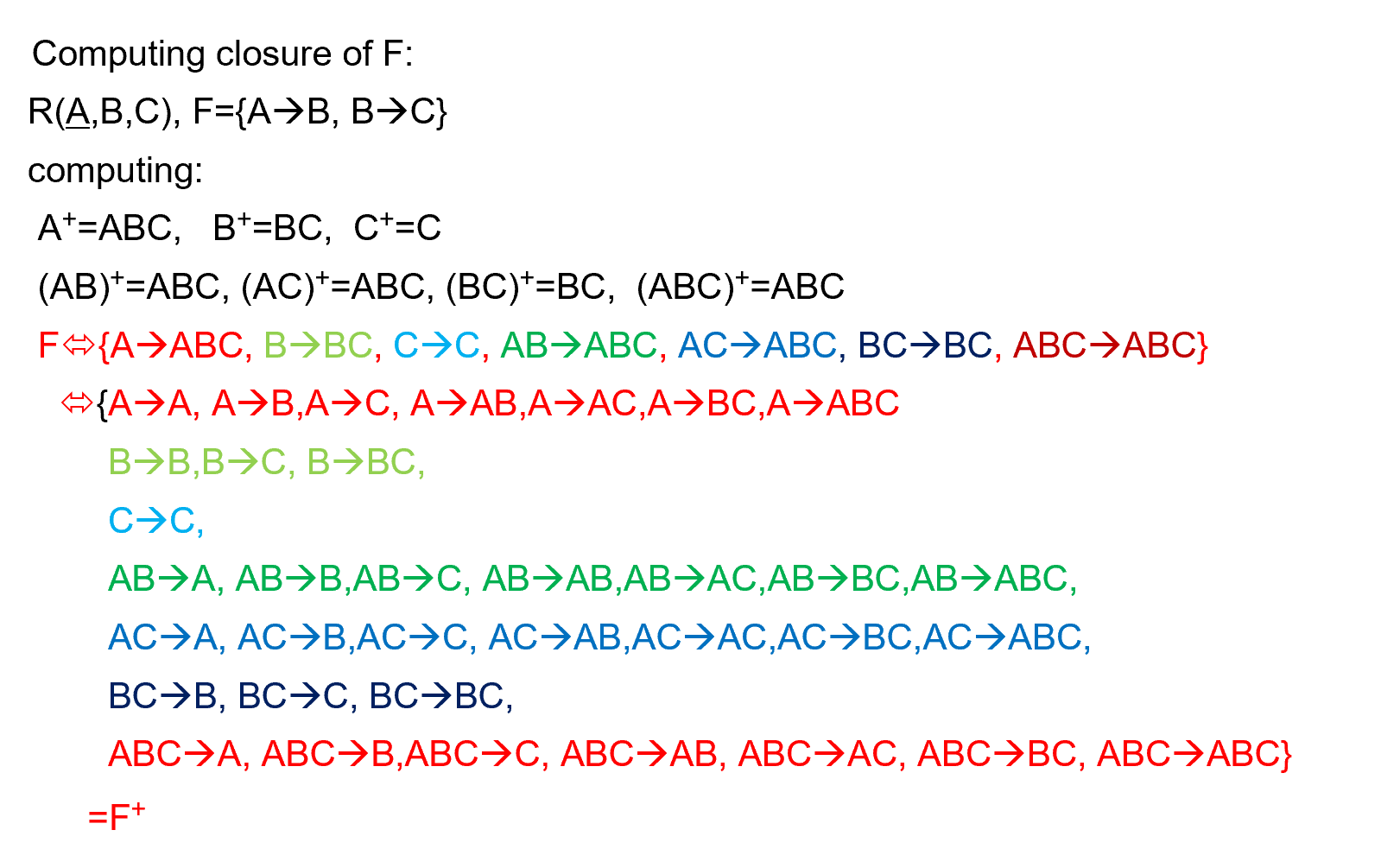
Canonical Cover(正则覆盖)¶
函数依赖是最简单的形式,不存在冗余的函数依赖。
a canonical cover of F is a “minimal” set of functional dependencies equivalent to F, having no redundant dependencies or redundant parts of dependencies.
Example
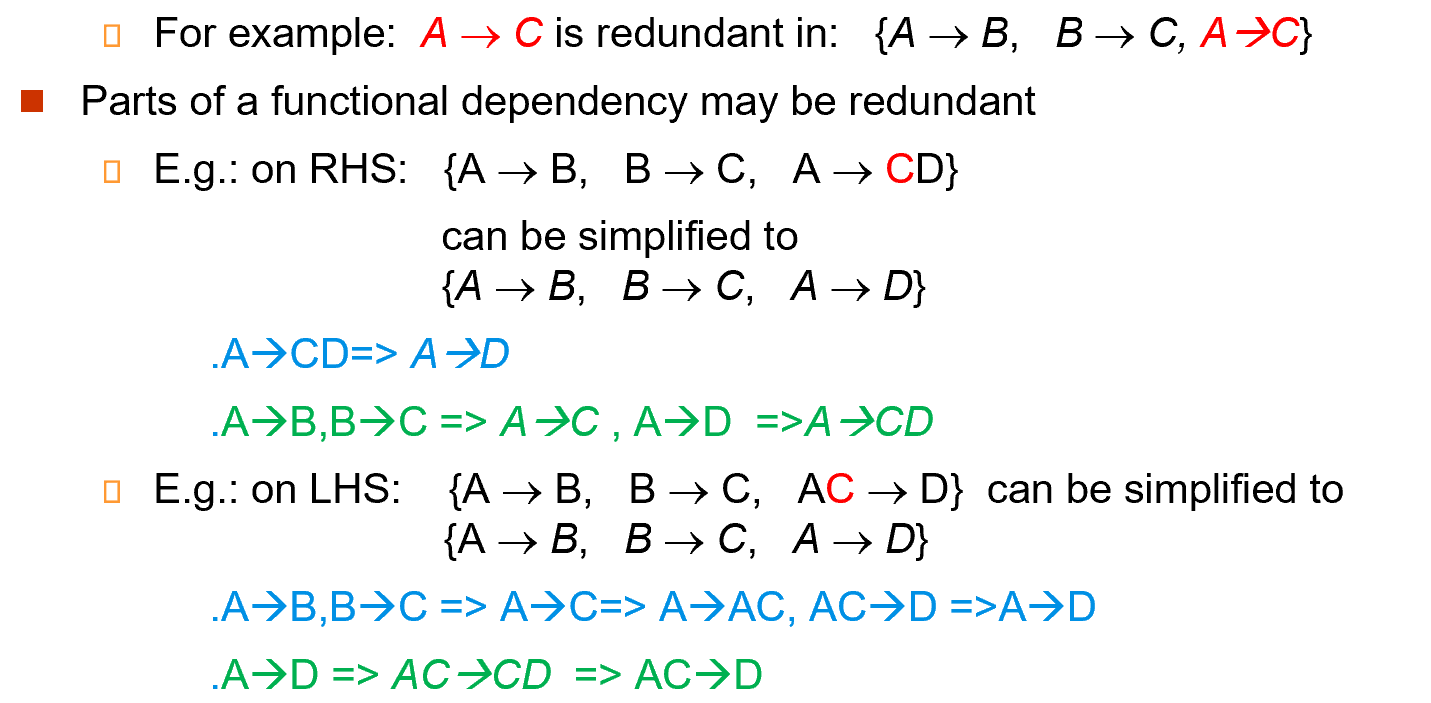
A canonical cover for \(F\) is a set of dependencies Fc such that
- \(F\) logically implies all dependencies in \(F_c\)
- \(F_c\) logically implies all dependencies in \(F\)
- No functional dependency in \(F_c\) contains an extraneous attribute
- Each left side of functional dependency in \(F_c\) is unique.

Computing a Canonical Cover
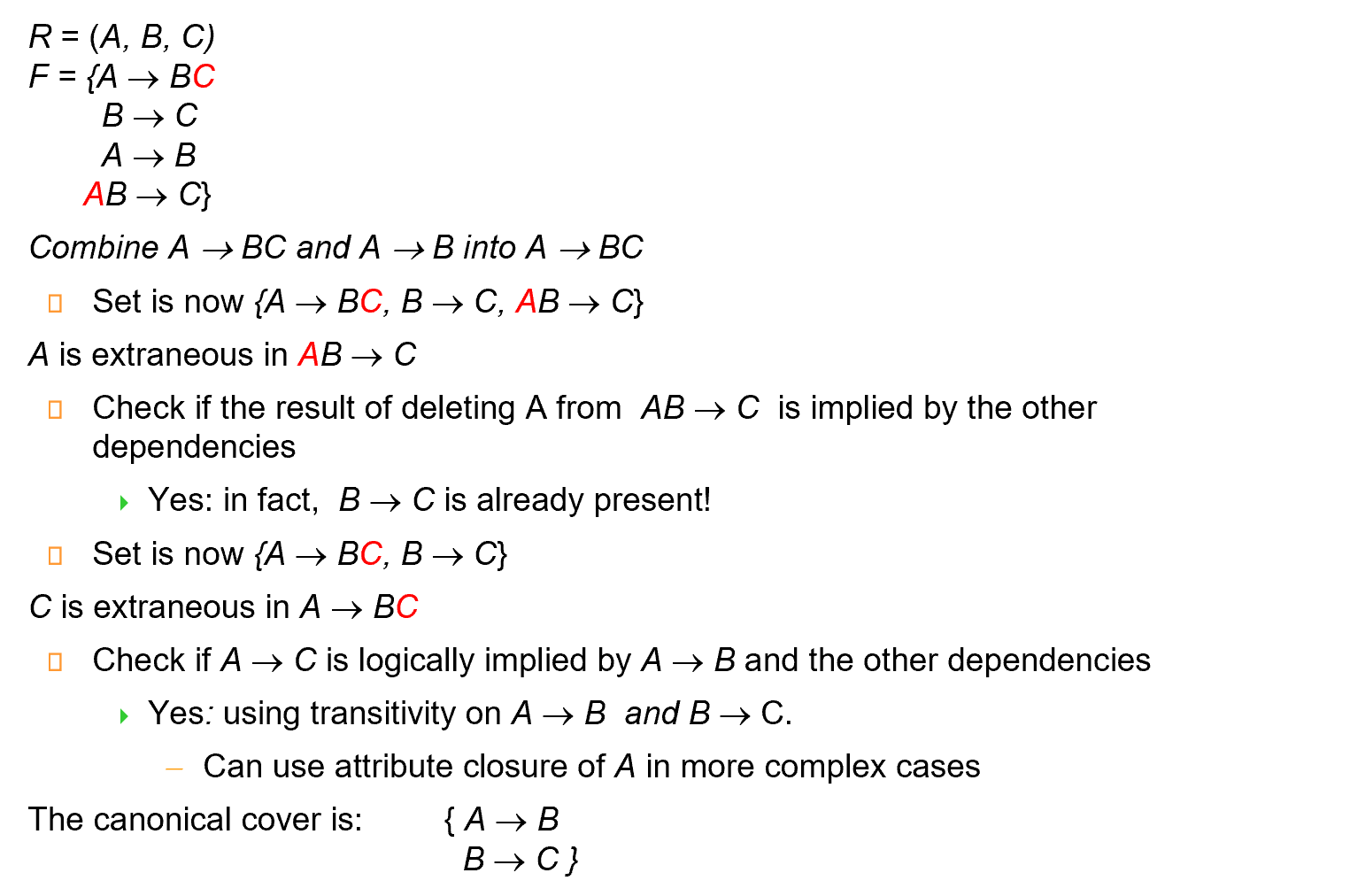

Boyce-Codd Normal FormAZSX¶
A relation schema \(R\) is in BCNF with respect to a set \(F\) of functional dependencies if for all functional dependencies in \(F^+\) of the form where \(\alpha \subseteq R\) and \(\beta \subseteq R\), at least one of the following holds
- \(\alpha \rightarrow \beta\) is trivial
- \(\alpha\) is a superkey for \(R\).
任何非平凡的函数依赖的左边都是一个 key.
Decomposing a Schema into BCNF¶
对于不是 key 的函数依赖,就把它分解出来作为单独的关系模式。
Suppose we have a schema \(R\) and a non-trivial dependency \(\alpha\rightarrow \beta\) causes a violation of BCNF. We decompose \(R\) into:
\((\alpha \cup \beta)\) and \((R-(\beta-\alpha))\)
\(\alpha\) 作为两个关系模式的公共属性,也是一个关系的 key, 这样才是无损分解。

Example

Dependency Preservation¶
依赖保持:原来的函数依赖,都可以在分解后的函数依赖中得到单独检验。否则需要把几个关系连接在一起才能检验依赖的,称为依赖不保持。
Constraints, including functional dependencies, are costly to check in practice unless they pertain to only one relation.
If it is sufficient to test only those dependencies on each individual relation of a decomposition in order to ensure that all functional dependencies hold, then that decomposition is dependency preserving (保持依赖). (如果通过检验单一关系上的函数依赖,就能确保所有的函数依赖成立,那么这样的分解是依赖保持的) (或者,原来关系R上的每一个函数依赖,都可以在分解后的单一关系上得到检验或者推导得到。) Because it is not always possible to achieve both BCNF and dependency preservation, we consider a weaker normal form, known as third normal form.
Let \(F_i\) be the set of all functional dependencies in \(F^+\) that include only attributes in \(R_i\). (\(F_i\): the restriction of \(F\) on \(R_i\))
- A decomposition is dependency preserving, if \((F_1\cup F_2 \cup \ldots \cup F_n )^+ = F^+\)
- If it is not, then checking updates for violation of functional dependencies may require computing joins, which is expensive.
Example

Example

Third Normal Form¶
任何一个非平凡函数依赖,如果左边不是一个 super key, 那么右边必须包含在一个 candidate key 里面。
A relation schema \(R\) is in third normal form (3NF) if for all: $\alpha\rightarrow \beta $ in \(F^+\) at least one of the following holds:
- \(\alpha\rightarrow \beta\) is trivial (i.e., \(\beta \in \alpha\))
- \(\alpha\) is a superkey for R
- Each attribute A in \(\beta-\alpha\) is contained in a candidate key for \(R\).
候选码有很多个,包含在某一个候选码即可。
Example

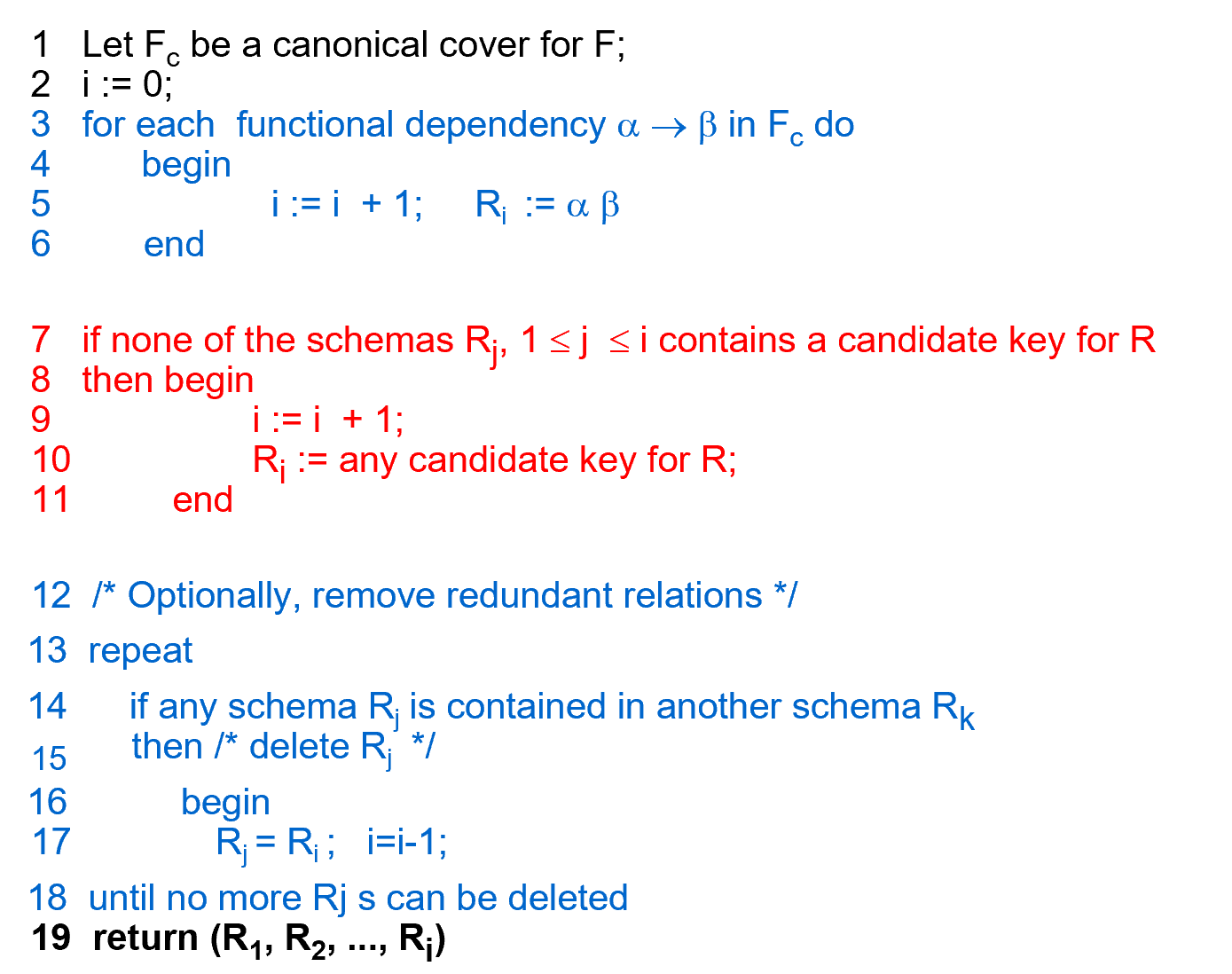
Goals of Normalization
In the case that a relation scheme R is not in “good” form, decompose it into a set of relation scheme \(\{R_1, R_2, \ldots, R_n\}\) such that
- each relation scheme is in good form (i.e., BCNF or 3NF)
- the decomposition is a lossless-join decomposition
- Preferably, the decomposition should be dependency preserving
E-R Modeling and Normal Forms
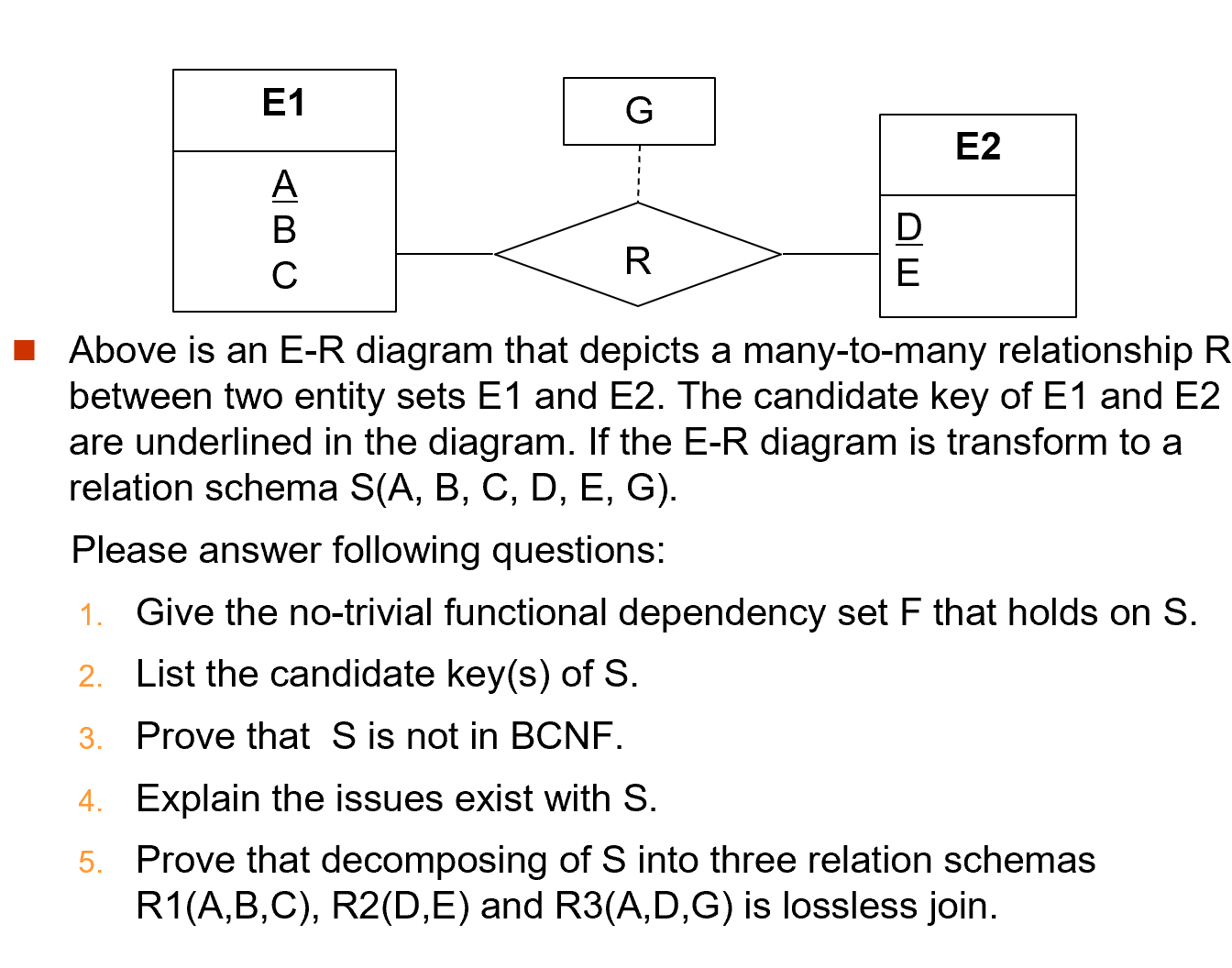
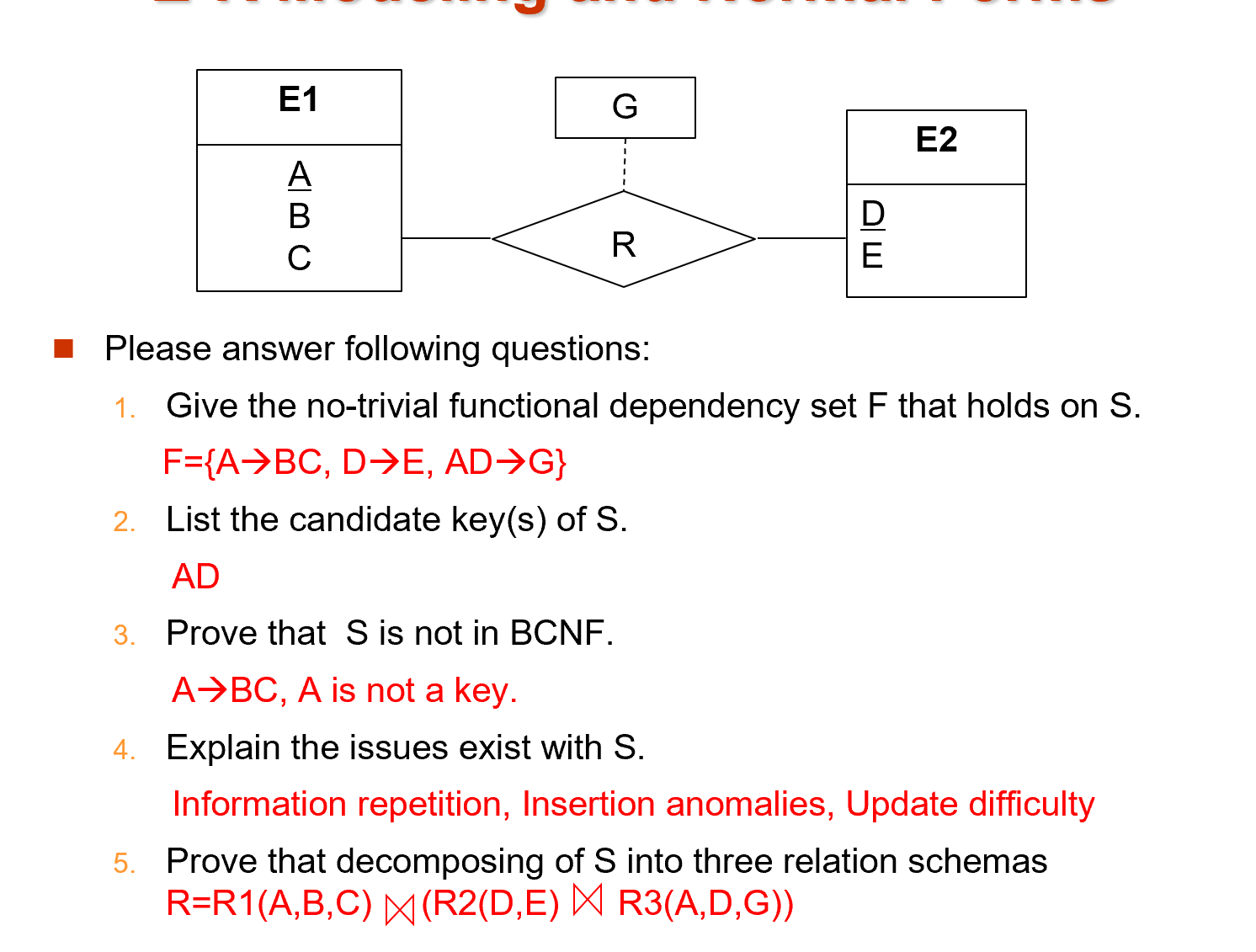
这里的无损分解,先指定一个路径,考虑每两个关系直接是否无损(公共属性是否为其中一个关系的 key)。
Multivalued Dependencies¶
There are database schemas in BCNF that do not seem to be sufficiently normalized.
Example


存在两种不相关的多值依赖。老师 id 可以多值决定 child_name, 又可以多值决定 phone, 但这两个属性是不相关的,放在一个表里就会组合。
第二张图的为 Fourth Normal Form (4NF).
四范式:不存在非平凡的多值依赖。
Let R be a relation schema and let \(\alpha\subset R\) and \(\beta\subset R\). The multivalued dependency \(\alpha\rightarrow\rightarrow\beta\) holds on \(R\) if in any legal relation \(r(R)\), for all pairs for tuples \(t_1\) and \(t_2\) in \(r\) such that \(t_1[\alpha] = t_2 [\alpha]\), there exist tuples \(t_3\) and \(t_4\) in \(r\) such that:

A relation schema \(R\) is in 4NF with respect to a set \(D\) of functional and multivalued dependencies if for all multivalued dependencies in \(D^+\) of the form \(\alpha\rightarrow \rightarrow \beta\), where \(\alpha\subset R\) and \(\beta\subset R\), at least one of the following hold:
- \(\alpha\rightarrow \rightarrow \beta\) is trivial (i.e., \(\beta \subset \alpha\) or \(\alpha \cup \beta= R\))
即除了 \(\alpha,\beta\) 为没有其他属性。 - \(\alpha\) is a superkey for schema \(R\)
任何一个多值依赖,要么左边就是个 key, 要么这个依赖是平凡的。

E-R Modeling and Normal Forms
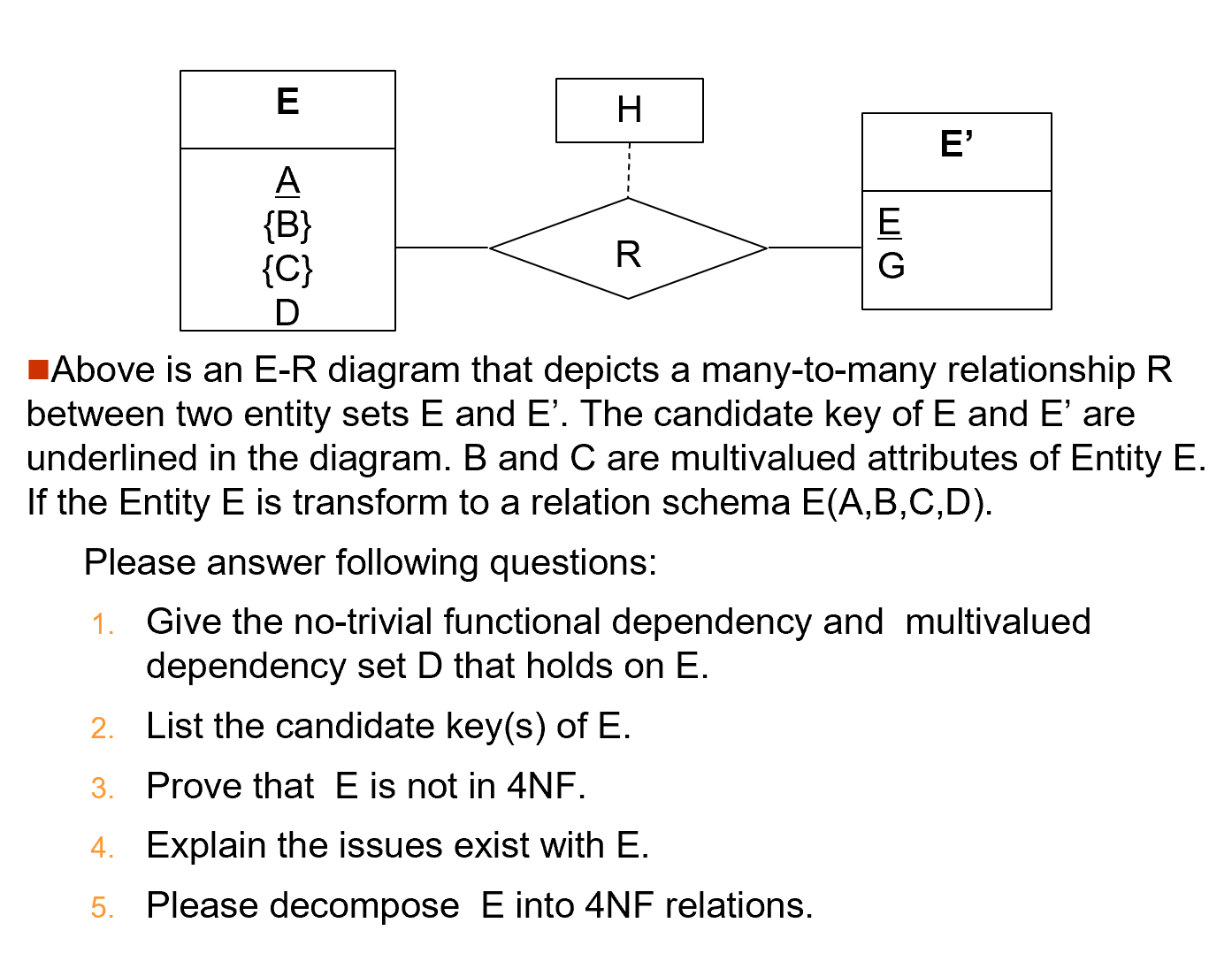

不是 BCNF, 因此也不是 4NF.
Overall Database Design Process¶
Denormalization for Performance
Some aspects of database design are not caught by normalization.
有时候我们需要引入冗余,来保持性能。
Example

创建日期: 2023年4月10日 23:04:31